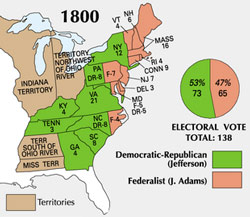|

Teacher
Resources
This
page contains specific resources developed for teachers using
this Exploration.

Entire
Unit | Bad Blood | Run
Up To The Duel | The Duel
Focusing
Event for Entire Unit:
History
of Dueling
The
history of dueling is facinating. Begin the unit by using the
General Court Martial of John Lawrence (1780). The complete
transcript of the court martial is online and provides an interesting
look at a duel. Lawrence was a Loyalist officer during the Revolution
and killed a British officer in a duel.
http://www.royalprovincial.com/military/courts/cmlawr.htm
What
was life like in 1804?
Population,
Diseases, The Arts, Crime & Punishment, Alcohol, Military
Timeline
for 1804:
January
1: Jean Jacques Dessalines proclaims Haiti's independence.
March
12, 1804: Federalist associate justice of the Supreme Court
Samuel Chase was impeached by Republican House of Representatives
for partisan conduct unbecoming to a judge. He was tried before
the Senate in 1805 and found not guilty.
May
14: The Lewis and Clark Expedition sets out from St. Louis.
The party will explore 8000 miles along the Missouri and Columbia
Rivers as far as the Pacific, returning in 1806.
July
4, 1804: New Jersey passed its "gradual emancipation"
act, essentially freeing any child born of slaves. This law,
with the earlier end of foreign import of slaves, was to bring
a final end to the practice of slavery. Under the terms of
the "gradual emancipation act," females born of
slave parents after July 4, 1804, would be free upon reaching
21 years of age, and males upon reaching 25. This act made
New Jersey the last Northern state to abolish slavery.
July
11: Alexander Hamilton is killed in a duel with Vice President
Aaron Burr.
Back
to Top
Bad
Blood
Use
the election of 1800 as a starting point to understand the
differences between Hamilton and Burr.
The
election of 1800 may be considered a realigning election
since it completed the turnover of power from the United
States Federalist Party, embodied in Alexander Hamilton,
to Thomas Jefferson and his United States Democratic-Republican
Party. Power shifted from the more industrial New England
to the Southern states and their agricultural interests.
This exacerbated tensions over slavery. |
 |
The
flaws incumbent in the electoral college were brought into
full focus in this election.
Under
the United States Constitution, each presidential elector
cast two votes, without distinction
as to which was for President or for Vice President.
The
recipient of the greatest number of votes was elected President,
while the Vice Presidency went to the recipient of the second
greatest number of votes. |
| Though
incumbent president John Adams was opposed once again by
1796 opponent Thomas Jefferson, it was Jefferson's running
mate, Aaron Burr, who caused the nation's first constitutional
crisis.
The
election was extremely close. It was the Constitution's
Three-fifths clause, which counted three-fifths of the slave
population in apportioning representation, that gave the
Republicans a majority in the electoral college. Jefferson
appeared to have won by a margin of eight electoral votes.
But a complication soon arose. Because each Republican elector
had cast one ballot for Jefferson and one for Burr, the
two men received exactly the same number of electoral votes.
|
| Presidential
Candidate |
Party |
State |
Popular
Vote: |
Electoral
Vote: |
| Thomas
Jefferson |
Democratic-Republican |
Virginia |
Unknown |
73 |
| Aaron
Burr |
Democratic-Republican |
New
York |
Unknown |
73 |
| John
Adams |
Federalist |
Massachusetts |
Unknown |
65 |
| Charles
Cotesworth Pinckney |
Federalist |
South
Carolina |
Unknown |
64 |
| John
Jay |
None |
New
York |
Unknown |
1 |
|
| Under
the Constitution, the election was now thrown into the Federalist-controlled
House of Representatives. Instead of emphatically declaring
that he would not accept the presidency, Burr declined to
say anything. So the Federalists faced a choice. They could
help elect the hated Jefferson - "a brandy-soaked defamer
of churches" - or they could throw their support to the
opportunistic Burr. Hamilton disliked Jefferson, but he believed
he was a far more honorable man than Burr, whose "public
principles have no other spring or aim than his own aggrandizement."
As the
stalemate persisted, Virginia and Pennsylvania mobilized
their state militias. Recognizing, as Jefferson put it,
"the certainty that a legislative usurpation would
be resisted by arms," the Federalists backed down.
After six days of balloting and 36 ballots, the House of
Representatives elected Thomas Jefferson the third president
of the United States. And as a result of the election, Congress
adopted the Twelfth Amendment to the Constitution, which
gives each elector in the Electoral College one vote for
president and one for vice president.
|
|
|
Back
to Top
Run
Up To The Duel
Use
the timeline of events leading up to the duel as a way to introduce
this section.
http://www.pbs.org/wgbh/amex/duel/timeline/index.html
Possible student activity from PBS' The Duel: What
led Alexander Hamilton and Aaron Burr to become deadly enemies?
Ask students to compare and contrast
the two men
using
two columns headed "Hamilton" and "Burr," with
the following categories listed at the left for consideration:
family background, education, military service, political
allegiance, political aspirations, political methods, public
office held.
Use this comparison
template (Microsoft
Word format)
When they have finished,
ask them to draw conclusions from their findings, whether
in a
discussion or a report:
- What evidence, if any, might
lead you to expect that the two would become enemies?
- How
were they
alike?
- How were they different?
- How were they at
odds?
- Were they representative of larger antagonistic social
and political
groups?
- Do their differences echo in contentious American society and politics today?
Back
to Top
The
Duel
PBS
produced a film named The Duel and developed a comprehensive
website
on the Duel. In addition to transcripts of the film, there
is a history of Dueling:
http://www.pbs.org/wgbh/amex/duel/index.html
Read the Code
Duello: The Rules of Dueling.
http://www.pbs.org/wgbh/amex/duel/sfeature/rulesofdueling.html
Back
to Top
|
